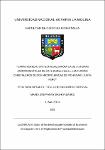Mostrar el registro sencillo del ítem
Caracterización tecnico-económica de sistemas agroforestales de café (Coffea arabica L.) en fundos cafetaleros de dos microcuencas de Pichanaki, Junín - Perú
| dc.contributor.advisor | Chuquicaja Segura, Carlos Edmundo | |
| dc.contributor.advisor | Cornejo Herrera, José | |
| dc.contributor.author | Bashi Pizarro, María Steffanny | |
| dc.date.accessioned | 2022-05-24T03:24:50Z | |
| dc.date.available | 2022-05-24T03:24:50Z | |
| dc.date.issued | 2021 | |
| dc.identifier.uri | https://hdl.handle.net/20.500.12996/5359 | |
| dc.description | Universidad Nacional Agraria La Molina. Facultad de Ciencias Forestales. Departamento Académico de Industrias Forestales | es_PE |
| dc.description.abstract | El estudio busca caracterizar técnica y económicamente, fundos cafetaleros manejados bajo sistemas agroforestales (SAF), y diferentes especies como componente forestal, en dos microcuencas de Pichanaki, Junín. La caracterización técnica, consistió en evaluar tres tipos de parámetros: Características socioeconómicas del productor, Características biofísicas de los fundos cafetaleros, y Características del manejo del SAF. La caracterización económica se realizó a través del análisis de tres SAF recurrentes en la zona de estudio: SAF típico (Inga spp.), SAF con especie maderable 1 (Pinus tecunumanii), y SAF con especie maderable 2 (Cedrela angustifolia). Se utilizó los indicadores VAN y TIR, además se realizó el análisis de sensibilidad para dos parámetros: Precio de venta del café, y Costo de mano de obra. En la caracterización técnica, se observa que cerca al 78% de los fundos cafetaleros es administrado por hombres, y el 22% es administrado por mujeres; el 69,4% posee título de propiedad de sus tierras. El 49% de los productores pertenece a alguna cooperativa cafetalera, y el 41%, presenta certificación orgánica. El 69,4% de los productores presenta fundos con área disponible para reforestación bajo diferentes sistemas; y en promedio, cada fundo presenta 3,5 hectáreas para reforestación. Los sistemas de plantación desarrollados en la zona son: sistemas agroforestales, macizo, linderos y enriquecimiento de bosques. El 45% de los productores ha instalado algún sistema de plantación forestal, el sistema más recurrente es el de SAF de café. En el análisis de Rentabilidad para un periodo de 21 años y tasa de descuento de 10%, se determinó que el VAN más alto corresponde al SAF con C. angustifolia (S/. 24 278,83), y TIR de 24%; el VAN más bajo fue del SAF típico (S/. 21 177,67), y TIR de 27%, mientras que el SAF con P. tecunumanii tuvo como VAN un valor intermedio: 23 294,67 y TIR: 24%. | es_PE |
| dc.description.abstract | The study seeks to characterize technically and economically, coffee farms managed like agroforestry systems (SAF), and different species as a forest component, in two micro basins of Pichanaki, Junín. The technical characterization consists in evaluating three types of parameters: Socio-economic characteristics of the producer, Biophysical characteristics of coffee farms, and Characteristics of SAF management. The economic characterization was carried out through the analysis of three recurrent SAFs in the study area: typical SAF (Inga spp.), SAF with timber species 1 (Pinus tecunumanii), and SAF with timber species 2 (Cedrela angustifolia). The VAN and IRR indicators were considered, in addition, a sensitivity analysis was carried out for two parameters: Coffee sale price, and Labor cost. In the technical characterization, it is observed that about 78% of coffee farms are administered by men, and 22% are administered by women; 69.4% own the title to their land. 49% of the producers belong to a coffee cooperative, and 41% have organic certification. 69.4% of the producers present farms with available area for reforestation under different systems; and on average, each farm has 3.5 hectares for reforestation. The planting systems developed in the area are: agroforestry systems, massifs, boundaries and forest enrichment. 45% of the producers have installed some forest plantation system, the most recurring system is that of coffee SAF. In the analysis of Profitability for a period of 21 years and a discount rate of 10%, the highest NPV corresponding to the SAF was determined with C. angustifolia (S /. 24 278.83), and IRR of 24%; the lowest NPV was the typical SAF (S /. 21 177.67), and IRR of 27%, while the SAF with P. tecunumanii had an intermediate value as NPV: 23 294.67 and IRR: 24%. | en_US |
| dc.format | application/pdf | en_US |
| dc.language.iso | spa | es_PE |
| dc.publisher | Universidad Nacional Agraria La Molina | es_PE |
| dc.rights | info:eu-repo/semantics/openAccess | en_US |
| dc.rights.uri | https://creativecommons.org/licenses/by-nc-sa/4.0/ | * |
| dc.subject | Sistemas agroforestales | es_PE |
| dc.title | Caracterización tecnico-económica de sistemas agroforestales de café (Coffea arabica L.) en fundos cafetaleros de dos microcuencas de Pichanaki, Junín - Perú | es_PE |
| dc.type | info:eu-repo/semantics/bachelorThesis | en_US |
| thesis.degree.discipline | Ciencias Forestales | es_PE |
| thesis.degree.grantor | Universidad Nacional Agraria La Molina. Facultad de Ciencias Forestales | es_PE |
| thesis.degree.name | Ingeniero Forestal | es_PE |
| dc.subject.ocde | https://purl.org/pe-repo/ocde/ford#4.01.02 | es_PE |
| renati.author.dni | 46276381 | es_PE |
| dc.publisher.country | PE | es_PE |
| dc.type.version | info:eu-repo/semantics/publishedVersion | en_US |
| renati.advisor.orcid | https://orcid.org/0000-0001-8666-0912 | es_PE |
| renati.advisor.dni | 07081514 | es_PE |
| renati.advisor.dni | 04067358 | es_PE |
| renati.type | https://purl.org/pe-repo/renati/type#tesis | es_PE |
| renati.level | https://purl.org/pe-repo/renati/level#tituloProfesional | es_PE |
| renati.discipline | 821016 | es_PE |
| renati.juror | Egoavil Cueva Gálvez, Graciela Isabel | |
| renati.juror | Meléndez Cárdenas, Miguel Ángel | |
| renati.juror | Begazo Curie, Karin |
Ficheros en el ítem
Este ítem aparece en la(s) siguiente(s) colección(ones)
-
CFO-IF Tesis [166]



